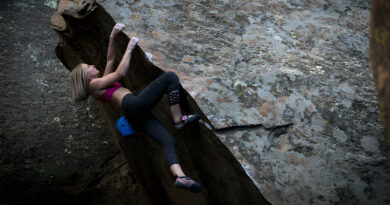How Should a Climbing Harness Fit?
A climbing harness should fit snugly and securely but not too tight because it will restrict your breathing or movement. The waist and leg loops should fit comfortably and stay in place when you move. You should be able to fit two fingers between your waist and the waist belt. Also, adjust the leg loops so that they are snug around your thighs.
The harness should be centered on your hips because the majority of the load is on your harness when you’re hanging or suspended. A centered harness means that the waistbelt is level and gear loops are symmetrical and in line with your hip bones. Make sure all the buckles and tie-in points are securely fastened and aligned.
Adjust the Waistbelt
The waistbelt of a climbing harness distributes your body weight evenly around your hips. So, make sure your waistbelt fits snugly and stays in place as you move.
To adjust the waistbelt, first, loosen all of the buckles and put the harness on like a pair of pants. Tighten the waistbelt until it is snug and secure around your hips. Two fingers should fit between your waist and the waistbelt, but no more. If the waistbelt is too loose, it can shift or twist, causing discomfort and impairing your balance. It can restrict your breathing and movement if it is too tight.
It’s also critical to keep the waistbelt centered on your hips. Examine the gear loops in front of a mirror to confirm this. They must be symmetrical and parallel to your hip bones. If they aren’t, make the necessary adjustments to the waistbelt.
Check the Buckles and Tie-In Points
You should use the buckles of a climbing harness to adjust the fit of the waistbelt and leg loops. Ensure that you securely fasten them before climbing. Check buckles including the one that connects the waistbelt to the leg loops.
The tie-in points on a climbing harness are where your rope connects to the harness. Typically, you will find them near the waistbelt. You must properly align them to ensure that your rope loads evenly across both tie-in points. You should check that the tie-in points are properly aligned, and securely tie and properly dress the knot used to attach the rope.
Other Considerations for Climbing Harness Fit
Aside from adjusting the waistbelt and leg loops, as well as checking the buckles and tie-in points, these are some additional things to consider.
Read the manufacturer’s instructions before using your harness for the first time. These instructions contain essential information on how to properly adjust and utilize your harness. They also provide details about weight limits, fit, and safety precautions. Familiarize yourself with this information to ensure you’re using the harness correctly.
Regular inspection of your harness is another important step. Check for any signs of wear or damage. These signs include frayed or cut webbing, and worn or broken buckles. The indications of these signs may compromise the harness’s security. If you identify any of these issues, discontinue using the harness immediately and replace it to maintain your safety.
Finally, it’s crucial to choose the right harness for your body type and climbing objectives. Different types of climbing (such as sport climbing, trad climbing, and ice climbing) require specific harness designs. Additionally, different body types may require different harnesses for optimal fit and comfort. Take the time to select a harness that suits your body and meets the requirements of your preferred climbing activities.




